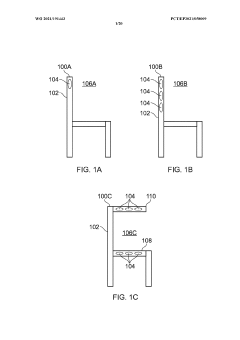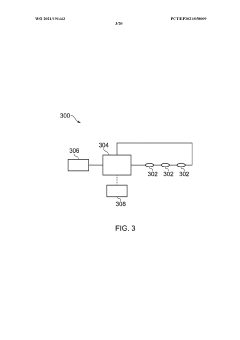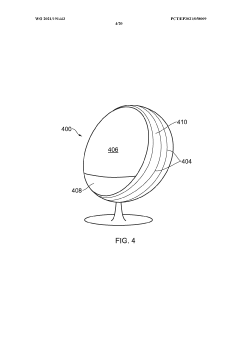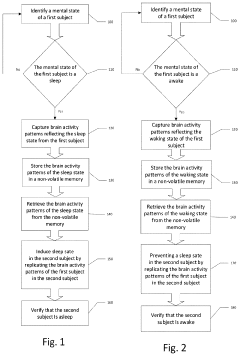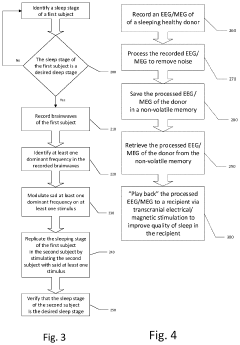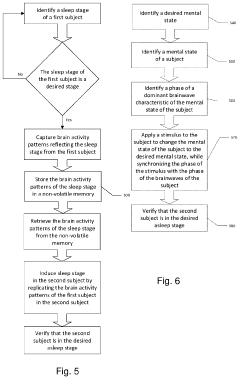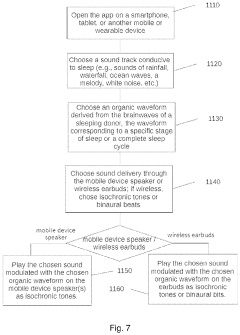Schumann Resonance Impact on Human Brainwaves
Schumann Resonance and Brainwave Research Overview
The Schumann Resonance, discovered by physicist Winfried Otto Schumann in 1952, refers to the electromagnetic resonances occurring between the Earth's surface and the ionosphere. These resonances, primarily at a frequency of 7.83 Hz, have been a subject of increasing interest in scientific research, particularly in relation to their potential impact on human brainwaves and overall well-being.
The study of Schumann Resonance and its effects on human brainwaves has gained momentum in recent years, driven by advancements in neuroimaging technologies and a growing interest in the relationship between environmental factors and human health. This research area intersects various scientific disciplines, including physics, neuroscience, and environmental science, making it a complex and multifaceted field of study.
Initial investigations into this phenomenon focused on establishing the existence and characteristics of the Schumann Resonance itself. As research progressed, scientists began to explore potential correlations between these natural electromagnetic frequencies and human physiological processes, particularly brain activity. The similarity between the primary Schumann Resonance frequency and certain human brainwave patterns, such as alpha waves, has sparked considerable interest and speculation about potential interactions.
Recent studies have employed sophisticated equipment to measure both Schumann Resonances and human brainwave activity simultaneously, seeking to identify any synchronization or entrainment effects. Some researchers hypothesize that the Schumann Resonance may act as a natural "tuning fork" for the brain, potentially influencing cognitive processes, sleep patterns, and overall mental states.
While the field has seen significant progress, it remains a subject of ongoing debate and investigation within the scientific community. Some studies have reported correlations between Schumann Resonance fluctuations and changes in human brainwave patterns, while others have found inconclusive or contradictory results. This variability in findings underscores the complexity of the subject and the need for further rigorous research.
The potential implications of this research are far-reaching, spanning from basic scientific understanding to practical applications in fields such as medicine, psychology, and environmental health. If a significant link between Schumann Resonances and human brainwave activity is conclusively established, it could lead to new approaches in treating various neurological and psychological conditions, as well as inform strategies for optimizing human cognitive performance and well-being.
Market Demand for Brainwave Entrainment Technologies
The market demand for brainwave entrainment technologies has been steadily growing in recent years, driven by increasing interest in non-invasive methods for cognitive enhancement and mental well-being. This trend is particularly evident in the wellness and personal development sectors, where consumers are seeking innovative solutions to improve focus, reduce stress, and enhance overall mental performance.
The global brain-computer interface market, which includes brainwave entrainment technologies, was valued at $1.2 billion in 2019 and is projected to reach $3.7 billion by 2027, according to Allied Market Research. This significant growth trajectory underscores the expanding market potential for technologies that interact with and influence brainwave patterns.
In the consumer sector, there is a rising demand for portable and user-friendly devices that can induce specific brainwave states. These products range from smartphone apps and headphones to more sophisticated wearable devices. The ease of use and accessibility of these technologies have contributed to their increasing popularity among a diverse user base, including professionals, students, and individuals seeking to improve their mental well-being.
The healthcare industry has also shown growing interest in brainwave entrainment technologies. Applications in areas such as stress reduction, sleep improvement, and pain management have garnered attention from both medical professionals and patients. The non-invasive nature of these technologies makes them an attractive alternative or complement to traditional treatments, particularly for conditions related to mental health and neurological disorders.
Corporate wellness programs represent another significant market segment. As companies increasingly recognize the importance of employee mental health and productivity, there is a growing demand for tools that can help reduce stress and improve cognitive function in the workplace. Brainwave entrainment technologies are being explored as potential solutions to enhance focus, creativity, and overall mental performance in professional settings.
The education sector is emerging as a promising market for brainwave entrainment technologies. With the increasing focus on personalized learning and cognitive enhancement, there is growing interest in tools that can potentially improve students' concentration, memory retention, and overall learning capabilities. This trend is likely to drive further innovation and adoption of brainwave-related technologies in educational settings.
As research on the Schumann Resonance and its potential impact on human brainwaves continues to evolve, it may open up new market opportunities for brainwave entrainment technologies. The possibility of harnessing natural electromagnetic frequencies for cognitive enhancement could lead to the development of novel products and applications, further expanding the market potential in this field.
Current State of Schumann Resonance Detection Methods
The detection of Schumann Resonances (SR) has evolved significantly over the past few decades, with current methods employing sophisticated equipment and advanced signal processing techniques. Modern SR detection systems typically utilize extremely low frequency (ELF) antennas coupled with highly sensitive magnetometers to capture the weak electromagnetic signals.
One of the most common approaches involves the use of induction coil magnetometers, which are capable of detecting minute changes in the Earth's magnetic field associated with SR. These sensors are often deployed in remote locations to minimize interference from human-made electromagnetic noise. Advanced signal processing algorithms, including Fast Fourier Transform (FFT) and wavelet analysis, are then applied to extract the SR signals from the background noise.
Another prevalent method utilizes Superconducting Quantum Interference Devices (SQUIDs), which offer unparalleled sensitivity in measuring magnetic fields. SQUID-based systems can detect SR with exceptional precision, even in urban environments where electromagnetic interference is high. However, the requirement for cryogenic cooling makes SQUID systems more complex and costly to operate.
Recent advancements in solid-state magnetometers, such as fluxgate and optically pumped magnetometers, have provided alternatives that balance sensitivity with practicality. These sensors offer good performance without the need for extreme cooling, making them suitable for long-term, continuous SR monitoring.
Global networks of SR detection stations have been established to provide comprehensive data on SR variations across different geographical locations. These networks enable researchers to study the global distribution of SR and its temporal variations, contributing to a better understanding of Earth-ionosphere cavity dynamics and potential correlations with various geophysical phenomena.
Data acquisition systems have also improved, with high-resolution analog-to-digital converters and real-time processing capabilities allowing for continuous monitoring and analysis of SR. Cloud-based storage and processing solutions have further enhanced the ability to collect, share, and analyze large volumes of SR data across international research collaborations.
Despite these advancements, challenges remain in SR detection. Anthropogenic electromagnetic noise continues to be a significant issue, particularly in populated areas. Researchers are exploring novel noise reduction techniques, including adaptive filtering and machine learning algorithms, to improve signal-to-noise ratios in SR measurements.
The integration of SR detection with other geophysical monitoring systems, such as those for lightning detection and ionospheric studies, is an emerging trend. This multidisciplinary approach aims to provide a more comprehensive understanding of the Earth's electromagnetic environment and its potential influences on various natural systems, including human physiology.
Existing Solutions for Schumann-Brainwave Interaction Studies
01 Influence of Schumann resonance on human brainwaves
Research suggests that Schumann resonance, the Earth's natural electromagnetic frequency, can influence human brainwave patterns. This interaction may have implications for cognitive function, sleep patterns, and overall well-being. Studies have explored the potential benefits of aligning human brainwaves with Schumann resonance frequencies.- Influence of Schumann resonance on human brainwaves: Research suggests that Schumann resonance, the Earth's natural electromagnetic frequency, can influence human brainwave patterns. This interaction may have implications for cognitive function, sleep patterns, and overall well-being. Studies have explored the potential benefits of aligning human brainwaves with Schumann resonance frequencies for improved mental and physical health.
- Devices for generating Schumann resonance frequencies: Various devices have been developed to generate or simulate Schumann resonance frequencies for therapeutic purposes. These devices aim to create an electromagnetic environment similar to the Earth's natural field, potentially promoting relaxation, stress reduction, and improved sleep quality. Some devices are designed for personal use, while others are intended for larger spaces or clinical settings.
- Measurement and analysis of Schumann resonance effects on brainwaves: Advanced measurement techniques and analysis methods have been developed to study the effects of Schumann resonance on human brainwaves. These include EEG monitoring, spectral analysis, and other neuroimaging techniques to observe changes in brain activity when exposed to Schumann resonance frequencies. Such research aims to better understand the potential cognitive and physiological impacts of these natural electromagnetic fields.
- Applications in meditation and mindfulness practices: The relationship between Schumann resonance and human brainwaves has been explored in the context of meditation and mindfulness practices. Some researchers and practitioners believe that exposure to or synchronization with Schumann resonance frequencies can enhance meditative states, improve focus, and promote overall mental well-being. Various techniques and technologies have been developed to incorporate these frequencies into meditation practices.
- Therapeutic applications and potential health benefits: Research has investigated the potential therapeutic applications of Schumann resonance frequencies in relation to human brainwaves. Studies have explored their use in treating various conditions, including sleep disorders, anxiety, depression, and cognitive impairments. Some researchers propose that exposure to these frequencies may help restore natural biorhythms and promote overall health and well-being.
02 Devices for generating Schumann resonance frequencies
Various devices have been developed to generate or simulate Schumann resonance frequencies. These devices aim to create an electromagnetic environment that mimics the Earth's natural frequencies, potentially promoting relaxation, improved sleep, and enhanced cognitive performance. Some devices are designed for personal use, while others are intended for larger spaces.Expand Specific Solutions03 Measurement and analysis of Schumann resonance effects on brainwaves
Advanced measurement techniques and analysis methods have been developed to study the effects of Schumann resonance on human brainwaves. These include EEG monitoring, spectral analysis, and other neuroimaging techniques to observe changes in brain activity when exposed to Schumann resonance frequencies. Such research aims to quantify and understand the neurophysiological impacts of these electromagnetic fields.Expand Specific Solutions04 Therapeutic applications of Schumann resonance for brain health
Researchers have explored potential therapeutic applications of Schumann resonance frequencies for brain health. This includes using these frequencies to treat various neurological and psychological conditions, such as anxiety, depression, and sleep disorders. Some studies suggest that exposure to Schumann resonance may help regulate circadian rhythms and improve overall mental well-being.Expand Specific Solutions05 Integration of Schumann resonance in wellness and meditation practices
Schumann resonance frequencies have been incorporated into various wellness and meditation practices. This integration aims to enhance relaxation, improve focus, and promote a sense of connection with the Earth's natural rhythms. Some practitioners believe that aligning with these frequencies can lead to improved mental clarity and emotional balance.Expand Specific Solutions
Key Players in Neuroscience and Geomagnetic Research
The research on Schumann Resonance impact on human brainwaves is in an emerging stage, with growing interest from both academic institutions and private companies. The market size is expanding as more organizations recognize the potential applications in neuroscience and health. While still in its early phases, the technology is progressing rapidly. Leading institutions like Massachusetts Institute of Technology, California Institute of Technology, and University of Bern are at the forefront of this research. Companies such as Neuroenhancement Lab LLC and NeuroVigil, Inc. are also making significant contributions, indicating a competitive landscape that spans both academic and commercial sectors. The involvement of diverse players suggests a multidisciplinary approach to understanding and harnessing Schumann Resonance effects on brain activity.
Neuroenhancement Lab LLC
Massachusetts Institute of Technology
Core Innovations in Electromagnetic Field-Brain Coupling
- A magnetic field exposure system generating an amplitude-modulated low frequency magnetic field with a carrier frequency of 360 to 450 Hz and a modulation frequency of 0.5 to 100 Hz, with a field strength of 0.5 to 250 mT, specifically designed to expose organic cells or tissues to improve cell survival, proliferation, reduce stress, and enhance well-being.
- A method to induce deep non-REM sleep (SWS) using endogenous brain-derived waveforms, processed through statistical methods, for transcranial Endogenous Sleep-Derived stimulation (tESD), which enhances slow-wave sleep and immune response modulation, thereby improving vaccine efficacy and reducing cytokine storms.
Ethical Considerations in Electromagnetic Field Exposure
The ethical considerations surrounding electromagnetic field (EMF) exposure, particularly in the context of Schumann Resonance research and its impact on human brainwaves, are multifaceted and require careful examination. As this field of study progresses, it is crucial to address the potential risks and benefits associated with EMF exposure, ensuring that research and applications adhere to ethical standards and prioritize human well-being.
One primary ethical concern is the potential long-term health effects of EMF exposure. While many studies have shown no significant adverse effects from low-level EMF exposure, the scientific community remains divided on the potential risks of prolonged or high-intensity exposure. This uncertainty necessitates a precautionary approach in research design and implementation, with stringent safety protocols and continuous monitoring of participants' health during and after studies.
Informed consent is another critical ethical consideration. Participants in Schumann Resonance and brainwave studies must be fully informed about the nature of the research, potential risks, and expected outcomes. Researchers have an ethical obligation to provide clear, comprehensive information and ensure that participants understand the implications of their involvement. This includes disclosing any uncertainties or gaps in current knowledge regarding EMF exposure effects.
Privacy and data protection present additional ethical challenges. Brain activity data collected during these studies is highly sensitive and personal. Researchers must implement robust data security measures to protect participants' information from unauthorized access or misuse. Furthermore, there should be clear guidelines on data retention, sharing, and destruction, with participants having the right to withdraw their data from studies at any time.
The potential for unintended consequences must also be considered. If research demonstrates significant effects of Schumann Resonance on human brainwaves, there may be attempts to manipulate or exploit these findings for non-therapeutic purposes. Ethical guidelines must be established to prevent misuse of this knowledge, such as in non-consensual behavior modification or enhancement of cognitive abilities.
Equity in research participation and access to potential benefits is another ethical imperative. Studies should strive for diverse participant pools to ensure that findings are representative and applicable across different populations. Additionally, if beneficial applications are developed from this research, there is an ethical responsibility to ensure equitable access to these technologies, preventing exacerbation of existing health disparities.
Lastly, the environmental impact of EMF-related technologies and research must be considered. As studies on Schumann Resonance and brainwaves may involve the use of EMF-generating equipment, researchers have an ethical obligation to minimize any potential ecological disruptions and consider the broader environmental consequences of their work.
Regulatory Framework for Electromagnetic Field Research
The regulatory framework for electromagnetic field (EMF) research, particularly in the context of Schumann Resonance impact on human brainwaves, is a complex and evolving landscape. Various international bodies and national agencies have established guidelines and standards to ensure the safety of human exposure to electromagnetic fields.
The World Health Organization (WHO) plays a crucial role in coordinating global efforts to assess the health effects of EMF exposure. Through its International EMF Project, the WHO provides a framework for harmonizing EMF standards worldwide. This project aims to establish a scientific basis for EMF exposure limits and promote consistent regulatory approaches across different countries.
The International Commission on Non-Ionizing Radiation Protection (ICNIRP) is another key player in setting EMF exposure guidelines. ICNIRP's recommendations are widely adopted by many countries and serve as a basis for national regulations. These guidelines cover a wide range of frequencies, including those relevant to Schumann Resonance research.
In the United States, the Federal Communications Commission (FCC) is responsible for regulating EMF exposure from wireless communication devices. The FCC's guidelines are based on recommendations from the National Council on Radiation Protection and Measurements (NCRP) and the Institute of Electrical and Electronics Engineers (IEEE).
The European Union has established the EMF Directive (2013/35/EU) to protect workers from the risks associated with EMF exposure. This directive sets minimum requirements for member states to implement in their national legislation. It covers both direct and indirect effects of EMF exposure, including potential impacts on the nervous system.
Research on Schumann Resonance and its impact on human brainwaves falls within the broader category of bioelectromagnetics. While specific regulations for this area of study are not as well-defined as those for other EMF sources, researchers must still adhere to general principles of human subject research ethics and safety guidelines.
Institutional Review Boards (IRBs) play a crucial role in overseeing human subject research, including studies on EMF effects. These boards ensure that research protocols comply with ethical standards and minimize risks to participants. For Schumann Resonance studies involving human subjects, researchers must obtain IRB approval and follow strict protocols for participant safety and informed consent.
As the field of EMF research continues to evolve, regulatory frameworks are likely to adapt to new scientific findings. This may include the development of more specific guidelines for extremely low-frequency EMF research, such as that involving Schumann Resonances. Ongoing collaboration between researchers, policymakers, and regulatory bodies will be essential to ensure that the regulatory framework remains up-to-date and effective in protecting public health while enabling scientific progress.
